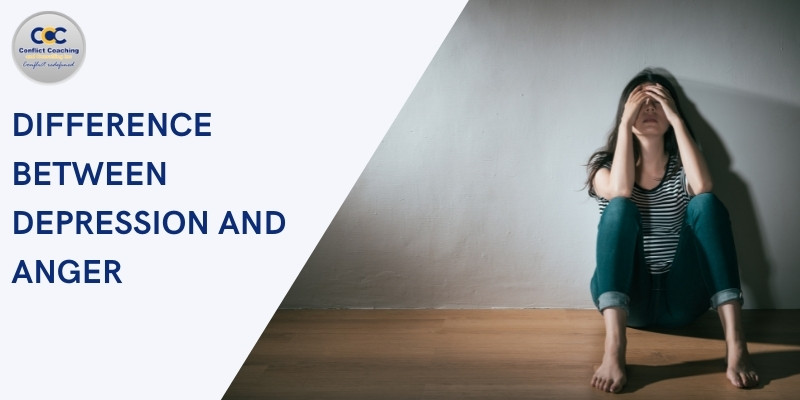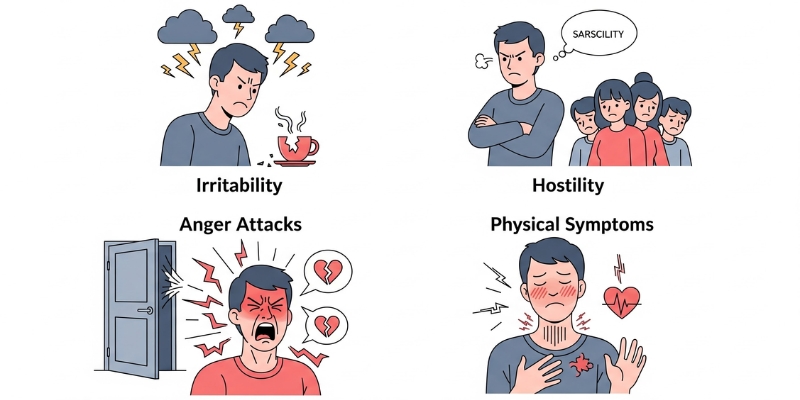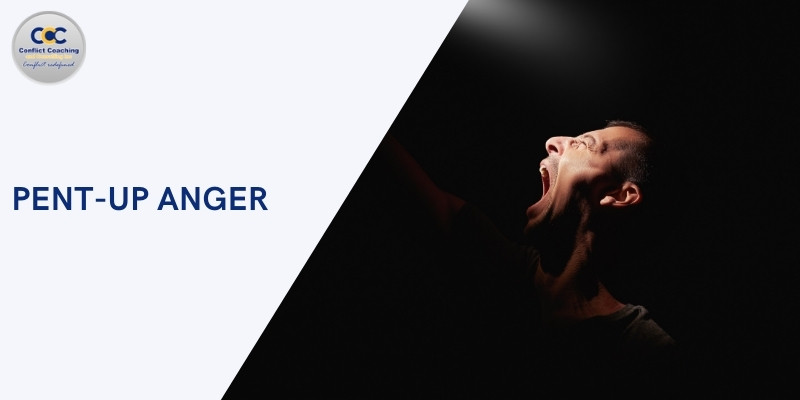
The Difference Between Depression and Anger
Anger and depression are two emotions that many people experience but often misunderstand, especially when they appear together.
Anger is a natural human reaction that can arise from frustration, fear, or feeling wronged.
Depression, on the other hand, is a mood disorder that affects how you think, feel, and handle daily life.
While they may seem like opposites, research shows they’re more connected than most people realize.
In fact, many people who struggle with depression also experience intense irritability or anger that they find hard to express or control.
In the U.S., millions silently deal with repressed anger, emotions that are buried instead of expressed.
Studies suggest that nearly 1 in 10 adults experiences depression each year, and a large portion of them also report symptoms of hidden or suppressed/repressed anger.
When anger isn’t acknowledged, it can build up over time, turning inward and fueling feelings of sadness, guilt, or hopelessness.
Understanding the connection between anger and depression is crucial because managing one often helps manage the other.
Recognizing your triggers, expressing emotions in healthy ways, and seeking professional help can make a real difference.
This blog explores how anger and depression interact, why they’re linked, and practical steps to help you break the cycle and move toward emotional balance.
Understanding Anger and Depression
Before exploring how anger and depression are connected, it’s important to understand what each emotion truly means on its own.
Both anger and depression affect the mind and body, but they express themselves differently.
Understanding their definitions and how they operate is the first step toward identifying when one emotion may be fueling the other.
Anger is a natural emotional response to situations that feel unfair, threatening, or frustrating.
It triggers physiological changes in the body (such as increased heart rate, muscle tension, and adrenaline release) as part of the body’s “fight or flight” response. While anger itself isn’t harmful, how it’s expressed can make a big difference.
There are several types of anger:
- Passive anger, which is hidden and expressed through sarcasm or avoidance.
- Active anger, which is openly displayed through verbal or physical reactions.
- Chronic anger, which lingers over time, can harm mental and physical health.
- Explosive anger, which erupts suddenly and intensely, often leads to regret or damaged relationships.
Recognizing which type of anger you experience most often can help you manage it before it turns inward or harms others.
Depression is a mood disorder that affects how a person feels, thinks, and behaves on a daily basis.
It’s more than just feeling sad (it’s a persistent state of low mood, emptiness, or hopelessness) that can last for weeks or months.
Common symptoms include loss of interest in activities, fatigue, difficulty concentrating, changes in appetite or sleep, and a constant sense of worthlessness or guilt.
Interestingly, anger and irritability can also be major symptoms of depression, especially in men. Instead of crying or appearing sad, some people express their depression through frustration, impatience, or emotional outbursts.
This happens because the brain regions that regulate mood and emotion (such as the amygdala and prefrontal cortex) can become imbalanced, making it harder to process emotions calmly.
By understanding that depression can sometimes hide behind anger, people can begin to recognize the signs earlier and seek the right support.
The Connection Between Anger and Depression
Anger and depression are more closely connected than most people realize.
While depression is commonly associated with sadness, withdrawal, and hopelessness, many individuals experience anger, irritability, or frustration as part of their depressive symptoms, especially when they feel powerless or misunderstood.
This link between the two emotions creates a complex emotional cycle that can make healing more difficult if left unaddressed.
Depression Often Leads to Irritability and Hostility
When someone is struggling with depression, they may have a much shorter emotional fuse. Feelings of exhaustion, guilt, and hopelessness can make even small problems feel overwhelming.
As a result, irritability becomes a defense mechanism; a way to push back against emotional pain or regain a sense of control.
Research shows that anger is particularly common among men and younger adults with depression, as they are more likely to externalize their emotional distress rather than express sadness openly.
Anger as a Response to Helplessness or Self-Blame
Many people with depression experience deep frustration with themselves or their circumstances.
This can lead to anger turned inward, where the person blames themselves for their perceived failures or lack of progress.
Over time, this internalized self-criticism builds resentment (both toward oneself and others), intensifying depressive thoughts.
The Vicious Cycle: How Unresolved Anger Worsens Depression
Unresolved anger can trap individuals in a painful feedback loop. When anger is suppressed or ignored, it doesn’t disappear; it lingers beneath the surface, fueling anxiety, guilt, and deeper sadness.
This unprocessed anger can worsen depressive symptoms by increasing feelings of isolation, shame, and emotional exhaustion.
Eventually, depression feeds the anger, and anger fuels the depression; creating a cycle that can be hard to break without awareness and professional help.
Recognizing this connection is key. By addressing both emotions, individuals can begin to understand the root of their pain and take meaningful steps toward emotional balance and recovery.
What Are the Symptoms of Anger and Depression
Anger and depression often overlap, making it difficult to recognize where one ends and the other begins. Both can show up emotionally, mentally, and physically, influencing how you think, feel, and behave.
While anger is usually seen as an outward reaction and depression as an inward withdrawal, many people experience both at the same time.
Understanding the specific symptoms of each can help you identify what’s really happening beneath the surface and seek the right kind of support.
Anger Symptoms in Depression
- Irritability: People with depression often feel easily irritated. Small inconveniences can trigger big emotional reactions like snapping at loved ones, losing patience in traffic, or getting upset over minor mistakes. This irritability often masks deeper sadness or exhaustion.
- Hostility: Depression can make you feel negative or distrustful. You might find yourself blaming others, making sarcastic remarks, or feeling resentful toward the world. This hostility can push people away, deepening feelings of loneliness.
- Anger Attacks: These are sudden, intense bursts of anger (yelling, slamming doors, or saying hurtful things) followed by guilt or regret. They often occur when emotions feel overwhelming or suppressed for too long.
- Physical Symptoms: Anger affects the body too. You might feel flushed, tense in the chest, shaky, or notice your heart racing; signs that your body is in “fight or flight” mode.
Depression Symptoms

Depression often brings a persistent low mood, fatigue, and a loss of interest in activities that once felt meaningful. You may feel emotionally numb or find it hard to get out of bed.
Other symptoms include sleep problems, changes in appetite, and feelings of worthlessness or guilt.
Importantly, anger can be a secondary symptom of depression, an outward expression of the inner pain and frustration you’re experiencing.
When sadness is turned inward or unexpressed, it can emerge as irritability, anger, or even rage.
Recognizing this connection helps in addressing both emotional and physical aspects of your well-being.
What Are the Causes of Anger and Depression
Anger and depression often share similar roots — emotional pain, stress, and unresolved inner conflict. These two experiences are not just emotional states but complex reactions influenced by multiple factors: psychological, biological, demographic, and environmental.
Understanding these causes can help explain why some people express their pain through anger while others internalize it as sadness or hopelessness.
Recognizing these triggers is the first step toward managing both emotions more effectively and breaking harmful patterns before they escalate.
Psychological Factors
Anger Turned Inward (Internalizing): When people suppress anger instead of expressing it, they often direct that emotion toward themselves. This can lead to harsh self-criticism, guilt, and feelings of worthlessness: all of which feed depression. The person may not appear angry outwardly, but feels trapped in self-blame and emotional pain.
Anger Turned Outward (Externalizing): On the other hand, some people express their inner distress through irritability, frustration, or aggression toward others. This outward anger can damage relationships and increase isolation, further worsening depressive symptoms. It becomes a destructive cycle: unexpressed sadness becomes anger, and anger deepens sadness.
Co-Occurring Conditions: People with anxiety disorders, substance use issues, or a history of trauma are at a higher risk of developing both anger and depression. These conditions can amplify emotional instability and make it harder to regulate responses to stress.
Biological Factors
Neurotransmitters like serotonin and dopamine play a crucial role in regulating both mood and aggression.
Low serotonin levels are often linked to impulsivity, irritability, and depression. When this chemical balance is disrupted (a condition known as serotonergic dysfunction), individuals may struggle to control emotional outbursts or experience persistent low mood.
Essentially, the same biological imbalance that causes depression can also heighten anger and frustration.
Demographic Factors
Gender: Men often experience and express depression differently than women. Due to societal norms that discourage emotional vulnerability, many men externalize their pain as anger or irritability instead of sadness.
Age: In children and teenagers, depression often looks like moodiness, defiance, or irritability rather than overt sadness. These behavioral signs are easy to mistake for typical adolescent behavior, but they can indicate underlying depression.
Environmental Factors
Environmental influences such as family conflict, workplace stress, financial strain, or exposure to violence can trigger both anger and depression.
A toxic or unstable environment often creates feelings of helplessness and resentment. Over time, constant exposure to such stressors can exhaust emotional reserves, leading to chronic frustration and depressive thinking.
Supportive environments, on the other hand, can act as a protective buffer, helping individuals process emotions in healthier ways.
Treatment for Anger and Depression
Treating anger and depression requires a holistic approach that addresses both the mind and body.
Since the two are often interconnected, effective treatment combines medication, therapy, and lifestyle strategies to regulate emotions, restore balance, and build healthier coping mechanisms.
While medication can help stabilize mood and reduce emotional intensity, therapy offers tools for understanding and managing triggers.
At the same time, self-help strategies empower individuals to take an active role in their emotional recovery. Let’s explore how each of these treatment categories contributes to healing.
Medication Options
Antidepressants: Medications such as Selective Serotonin Reuptake Inhibitors (SSRIs) and Serotonin-Norepinephrine Reuptake Inhibitors (SNRIs) help regulate serotonin and norepinephrine; brain chemicals linked to mood and emotion. These drugs can reduce irritability, emotional volatility, and symptoms of depression, providing a more stable emotional baseline.
Anger Management Medications: In some cases, doctors may prescribe mood stabilizers or antipsychotic medications to manage severe anger or aggression associated with depression. These medications help calm the nervous system, reducing impulsivity and emotional outbursts. They’re typically used under close medical supervision and combined with therapy for the best results.
Therapies
Cognitive Behavioral Therapy (CBT): CBT is one of the most effective treatments for both anger and depression. It helps you identify and challenge negative thought patterns such as “I’m worthless” or “Everyone’s against me” and replace them with healthier, more balanced beliefs.
Dialectical Behavior Therapy (DBT): Originally designed for intense emotional dysregulation, DBT teaches mindfulness and emotion regulation skills. It helps you pause before reacting to anger and develop tolerance for emotional discomfort, which can prevent depressive spirals.
Emotionally Focused Therapy (EFT): It focuses on understanding how emotions like anger serve as signals for unmet needs or fears. By processing these feelings safely, individuals learn to express anger constructively and build compassion for themselves and others.
Psychodynamic Therapy: This approach explores deep-seated emotional wounds that often stem from childhood. By uncovering unresolved conflicts or repressed anger, psychodynamic therapy allows for long-term emotional healing and a greater sense of self-awareness.
Interpersonal Therapy (IPT): IPT emphasizes improving communication and relationship dynamics. Since strained relationships often fuel both anger and depression, learning healthier interaction patterns can ease emotional tension and promote recovery.
Self-Help Strategies
Mindful Breathing Techniques: Practices like box breathing (inhale 4 seconds, hold 4, exhale 4, hold 4) or 4-7-8 breathing calm the body’s stress response, helping you think more clearly and prevent emotional escalation.
Progressive Muscle Relaxation (PMR): This technique involves tensing and then relaxing muscle groups, helping release physical tension caused by anger or anxiety. It’s especially useful before sleep or after stressful situations.
Exercise: Regular physical activity releases endorphins, the body’s natural mood boosters. Activities like walking, yoga, or strength training can reduce anger, improve sleep, and alleviate depressive symptoms.
Self-Compassion: Being kind to yourself, instead of criticizing your anger or sadness, promotes emotional healing. Self-compassion encourages acceptance and reduces the guilt that often accompanies depression.
Journaling: Writing about your feelings provides clarity and relief. Keeping an anger or mood journal can help you recognize patterns, triggers, and progress, making it easier to handle emotional challenges in the future.
Coping with Anger and Depression
Coping with anger and depression requires patience, self-awareness, and consistent emotional effort.
It’s not about eliminating these emotions entirely but learning to express and manage them in ways that promote healing instead of harm.
Both anger and depression can feel overwhelming when left unaddressed, but through intentional coping strategies (like healthy expression, identifying triggers, and seeking support), you can regain control and emotional balance.
Developing Healthy Emotional Expression: Learning to express anger healthily is one of the most important steps in emotional recovery.
Rather than bottling up feelings, try to channel them through open communication, physical activities, or creative outlets such as art, music, or journaling.
For instance, talking calmly about what frustrates you helps others understand your emotions without conflict, while exercise releases pent-up energy and reduces stress hormones.
The goal isn’t to suppress anger, but to acknowledge and release it constructively; turning a potentially destructive force into a tool for emotional insight and growth.
Identifying Triggers: Understanding your emotional and situational triggers can prevent anger and depression from escalating. These triggers may include stressful relationships, workplace pressure, or unresolved guilt.
Keeping a journal or mood tracker helps you pinpoint patterns and recognize early warning signs of emotional distress.
Once you identify your triggers, create a personal coping plan; this could include deep breathing, walking away from heated situations, or practicing mindfulness. Awareness is the first step toward breaking the cycle.
Building a Support System: Having a strong support network can make a tremendous difference in managing anger and depression.
Talking to trusted friends, family members, or joining support groups allows you to share your experiences and gain perspective. These conversations can ease emotional burden and remind you that you’re not alone.
If you notice that anger or depression is severely affecting your relationships, work, or self-esteem, it’s important to seek professional help. Therapists and counselors can guide you with personalized strategies and provide a safe space for emotional healing.
Prevention and Long-Term Management
Preventing and managing anger and depression over the long term involves building healthy habits and emotional resilience that keep your mind and body balanced.
It’s not just about treating symptoms, it’s about maintaining progress and preventing relapse.
Through mindfulness, consistent therapy, and self-care routines, individuals can strengthen emotional stability and reduce the intensity of future emotional challenges.
The goal is to cultivate a lifestyle that supports mental well-being and helps you stay in control, even during difficult times.
Building Emotional Resilience: Developing emotional resilience means learning how to respond to challenges without being overwhelmed by them.
Mindfulness and meditation are powerful tools for staying present and interrupting negative thought loops that often fuel anger and depression. These practices help you observe emotions without reacting impulsively.
Additionally, maintaining a healthy lifestyle (with regular exercise, a balanced diet, and proper sleep) creates a strong foundation for emotional regulation.
When your body is well-rested and nourished, your mind is better equipped to handle stress and frustration.
Ongoing Therapy and Support: Even after symptoms of anger or depression improve, ongoing therapy plays a vital role in long-term emotional health. Regular sessions with a therapist can help you manage stress, identify new triggers, and strengthen coping skills.
Joining anger management or depression support groups provides continued encouragement and accountability. These spaces allow you to share your journey, learn from others, and feel supported as you work toward emotional stability.
Maintaining Self-Care Practices: Self-care isn’t a one-time activity; it’s a continuous commitment to nurturing your mental health. Incorporate daily practices such as engaging in hobbies, spending time in nature, or connecting with loved ones to maintain a sense of joy and balance.
Regular relaxation activities, like listening to music, journaling, or taking mindful breaks, can help you manage stress before it builds up. Prioritizing these routines not only prevents burnout but also reinforces emotional well-being over time.
Frequently Asked Questions (FAQs)
Is it normal to feel angry when you’re depressed?
Yes, it’s completely normal. Many people with depression experience irritability or anger due to frustration, hopelessness, or feeling misunderstood.
Why am I so angry and depressed?
Anger and depression often occur together because both can stem from stress, trauma, or unexpressed emotions. When sadness or pain is internalized, it can surface as anger.
Is anger a symptom of depression?
Yes. Anger is a lesser-known but common symptom of depression, especially in men, who may express emotional pain through irritability or aggression rather than sadness.
How do I know if my anger is related to depression?
If your anger feels constant, overwhelming, or linked with low mood, fatigue, or hopelessness, it may be part of depression rather than a separate issue.
Can depression cause anger?
Yes. Depression can cause anger when feelings of helplessness or frustration build up without a healthy outlet for expression.
Can anger be a sign of depression?
Absolutely. Persistent anger, irritability, or rage can be emotional indicators of underlying depression, even when sadness isn’t obvious.
Can depression manifest as anger?
Yes. For some people, depression shows up as irritability, resentment, or emotional outbursts rather than typical sadness or withdrawal.
Is lashing out a sign of depression?
It can be. When emotional pain feels unbearable, some people express it by lashing out verbally or physically—it’s often a sign of deeper emotional distress.
Is anger part of depression?
Yes. Anger is a natural emotional response that can become intensified or chronic in people dealing with depressive thoughts and low self-esteem.
Can depression turn into anger?
Yes, untreated depression can evolve into anger over time. Suppressed sadness and frustration may transform into resentment or irritability toward oneself or others.
Conclusion
Understanding the connection between anger and depression is essential for breaking the emotional cycle they often create together.
Anger isn’t always just a surface reaction—it can be a sign of deeper emotional pain, frustration, or helplessness that depression amplifies.
Recognizing this link allows you to manage both emotions more effectively, rather than treating them as separate struggles.
If you find that your anger or low mood interferes with your daily life, relationships, or work, it’s important to seek professional help.
Therapies such as CBT, DBT, or anger management counseling, along with medication when necessary, can provide powerful tools for healing.
Remember, emotional wellness isn’t about suppressing anger or pretending to be happy; it’s about understanding your emotions, responding with compassion, and finding balance.
With time, therapy, and consistent self-care, it’s absolutely possible to regain control, rebuild peace, and nurture lasting mental and emotional health.





Responses